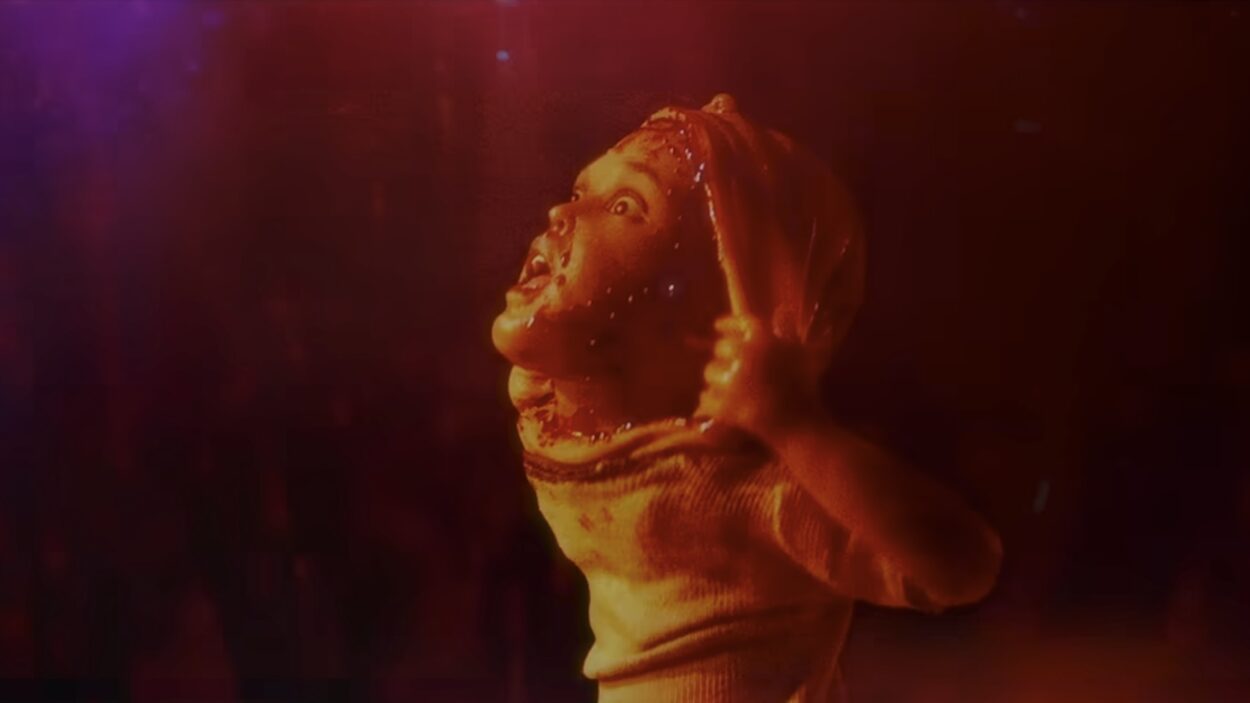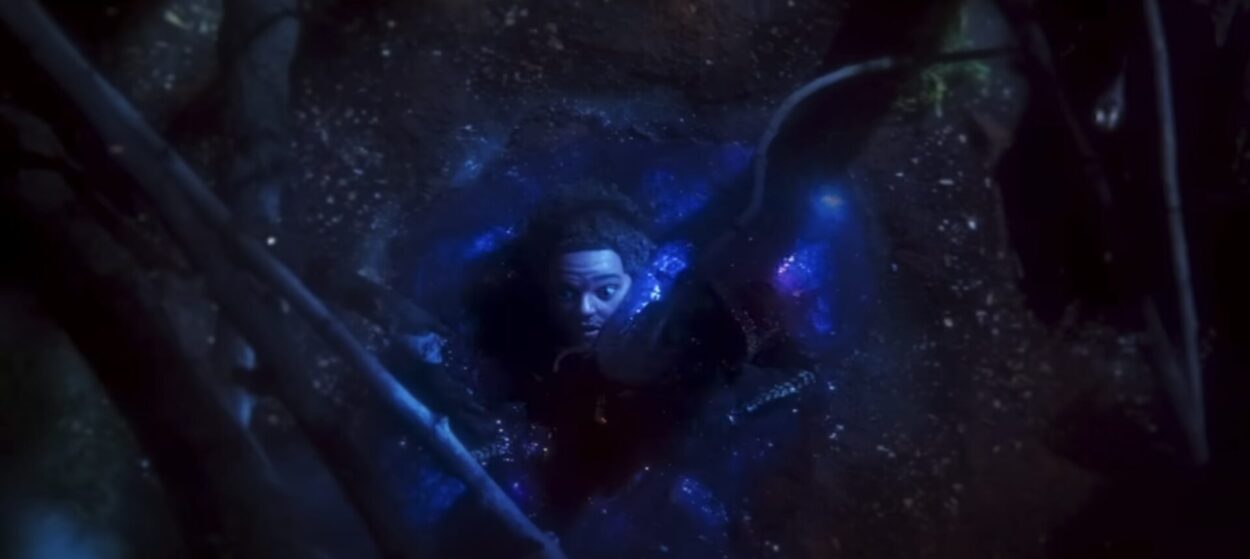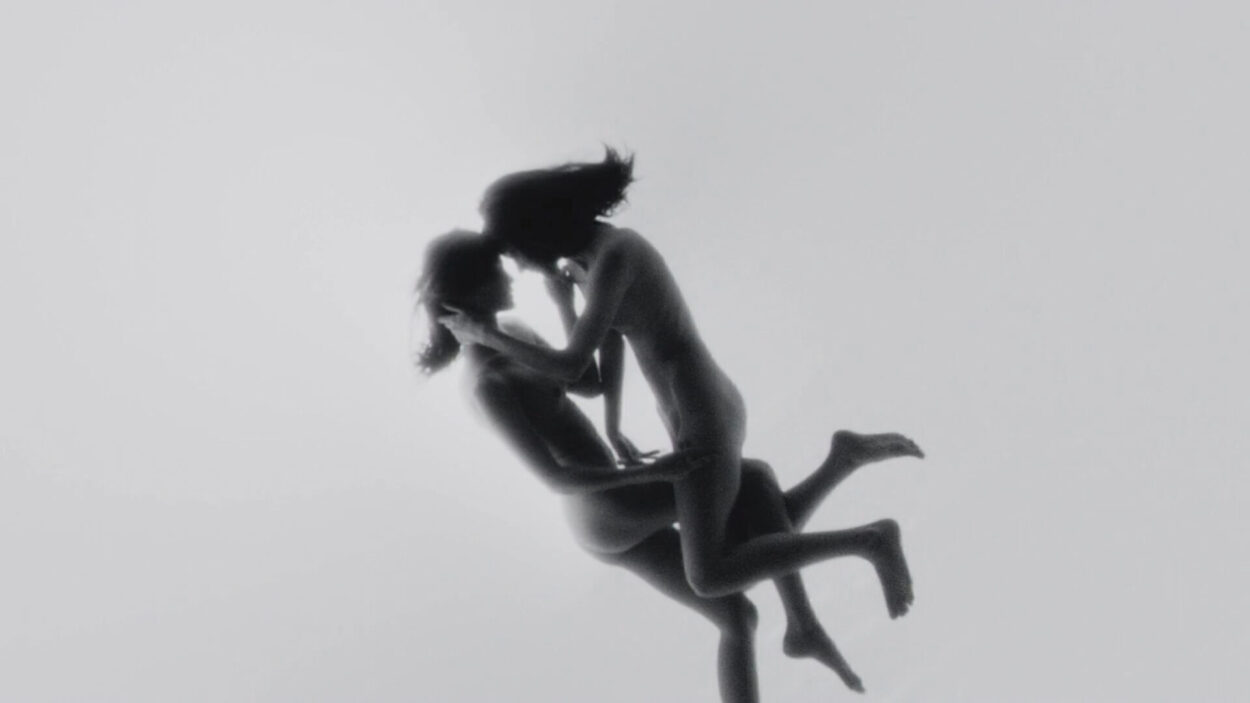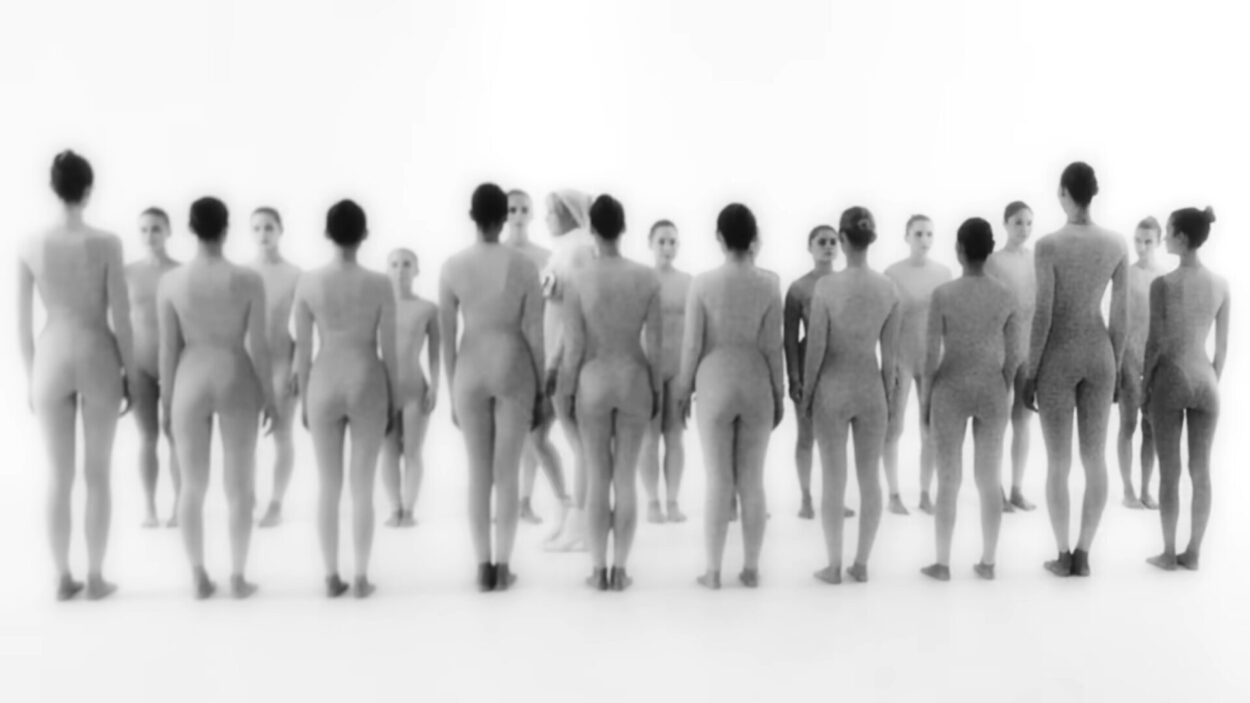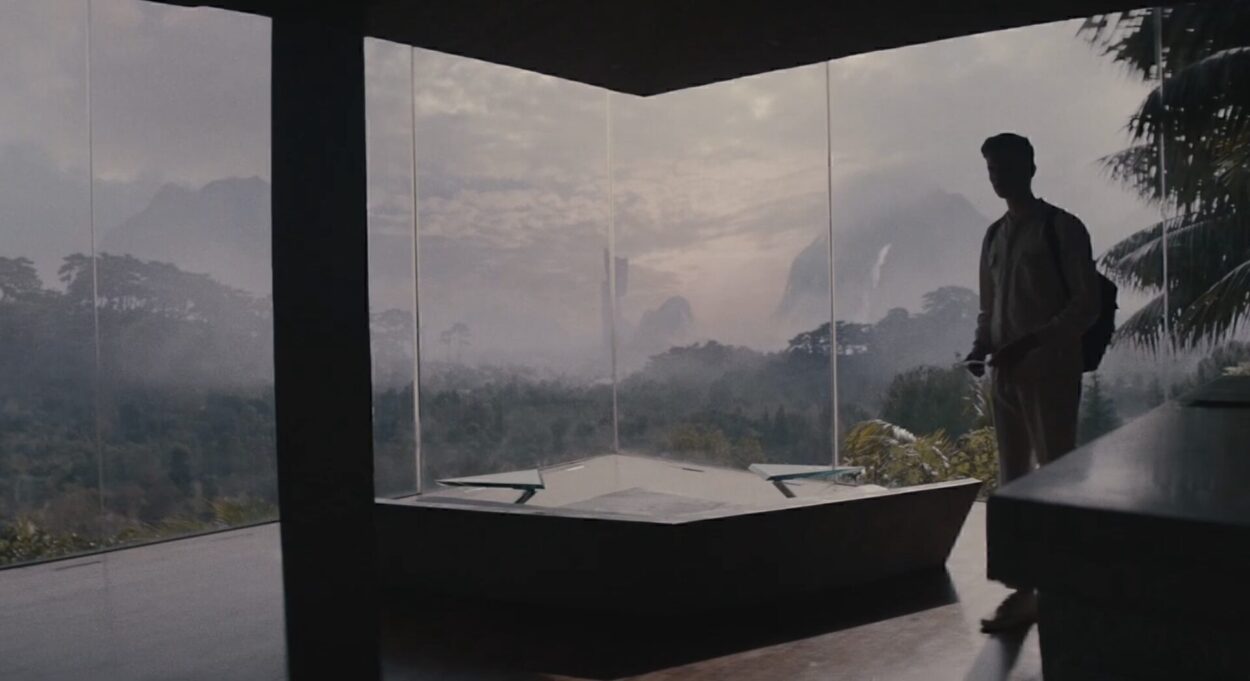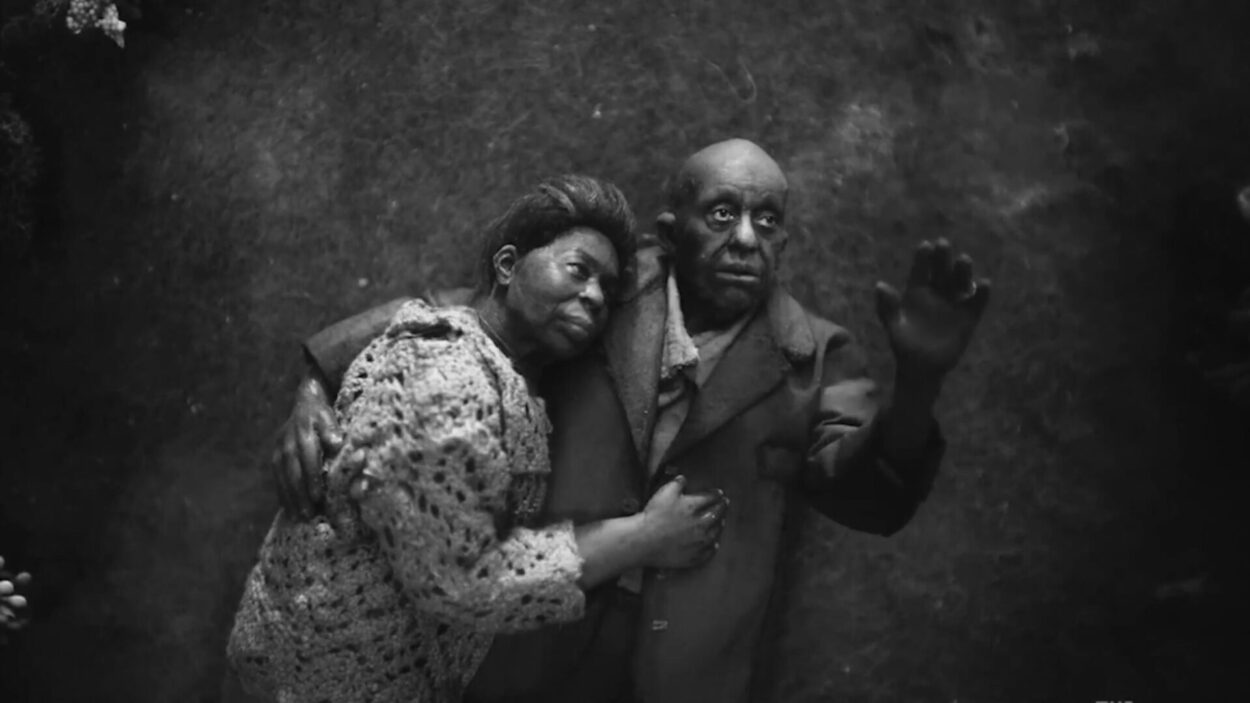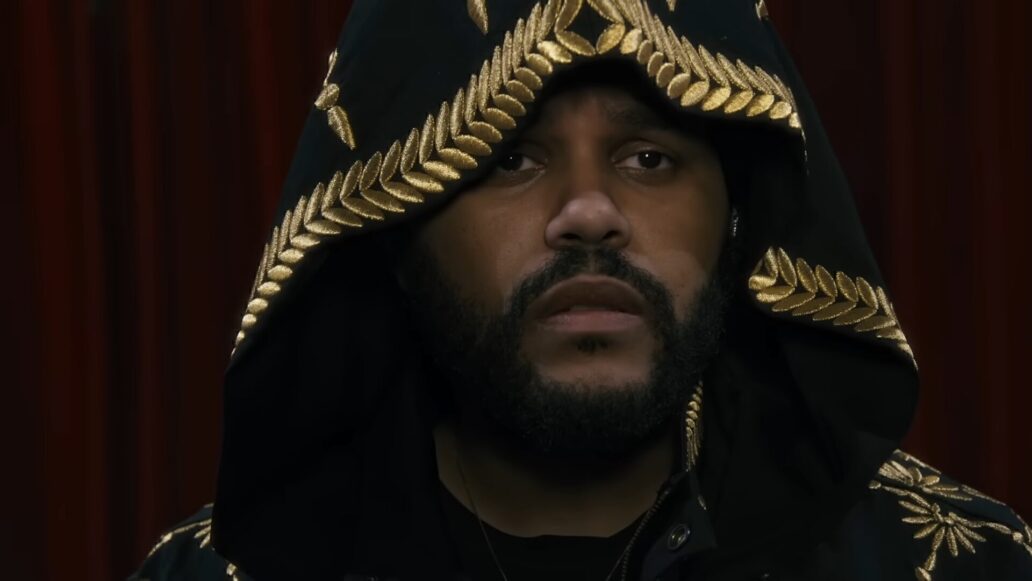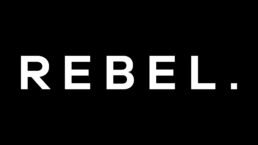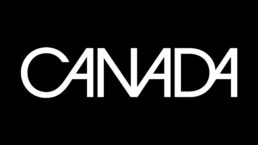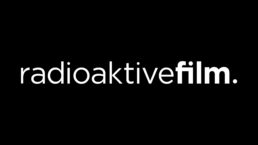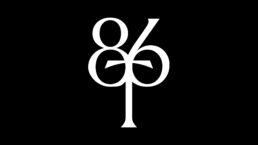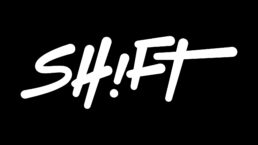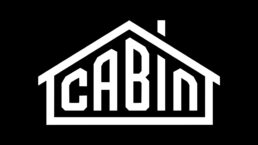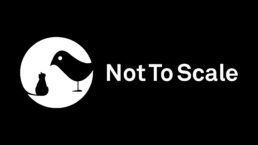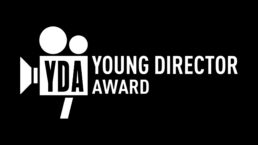From Perfect
Stephen: I have a ton of questions. Lots of them. I didn’t actually write down half of them because I went down a rabbit hole after watching Fuckkkyouuu and Divinity and Perfect, and I had to remind myself that this is actually an interview about the music video, so hopefully if we get some time I can drill into a bit about your features.
Eddie Alcazar: Oh yeah, for sure.
Perfect was staggering, an utterly beautiful piece of filmmaking. The cinematography is stunning, and every shot looks like it could be a Prada commercial. So let’s start there, if you don’t mind? In watching and re-watching Perfect, obviously there’s the segment where you jump into the black-and-white almost Neanderthal meets Mayan culture moments, and it immediately connected my head back to Fuckkkyouuu and the visually similar setup in that short film. In your mind is there a red thread between those segments either stylistically or conceptually?
Eddie: I feel like it’s a continuation a bit from what was established with Fuckkkyouu, but, you know, after doing so much black and white I wanted to just go pretty crazy with the colors and lean into a whole different world. And I feel I did that a bit with Perfect after Fuckkkyouuu, since that was a certain style that I love with black and white and Danny Hiele a DP that I work with a lot.
We were experimenting a lot with a specific film stock, 16 millimeter reversal in the earlier films, so for the black and white scene in Perfect we actually shot with the Phantom camera. I was curious to see how that would work because with 16 millimeter obviously it’s almost impossible to do a thousand frames per second. I’d really wanted to try that on Fuckkkyouuu but we weren’t able to because of the limitations of the camera so when it came to Perfect we were just pushing a little bit further.
As far as thematically, I think Perfect is its own kind of thing, you know? In Perfect the reason that we go into this primal state is more about going into the mind of the lead character, his dark side, if you will.
Looking at your work there’s a really strong conceptual and abstract dimension to it, not just visually, but in terms of the way you approach exploring the human psyche and internal psychological processes and all of those elements. It’s not just a stylistic device.
Eddie: All the projects I’ve done so far have, to some extent been kind of sketches to me; experimental sketches where I’m doing the best I can with my limitations and trying to explore ideas and different techniques, but also stuff that I’m interested in, but not necessarily going about it in the most narratively structured way. Trying to get away from the limitations, I guess, and see how I could play around with ideas and communicate them through a visual medium and sound. I think what connects them is my interest in this idea of helping to connect people to almost like a dream state. I think that’s probably the best way to explain it.
The Weeknd, live
You’ve had some amazing creative collaborations – input and support from the likes of Steven Soderbergh and Darren Aronofsky. How do those conversations and connections come about?
Eddie: Well, with Soderbergh and Perfect, I had a close friend Chris Santos who was one of the leads on a film of his and then that ultimately led to us sending him a rough cut just to get thoughts and opinions, which I did to a few people, it wasn’t just him. He came back and really liked it and wanted to meet and then it just kept on growing from there. He’s been very supportive and open to lending his help to creatives who are trying to do something new and fresh. People that, I guess, aren’t doing the normal thing.
He doesn’t really tell me what I ought to be doing in a prescriptive way or suggest right or wrong ways of doing things, if something should be this way or that way. He kind of wants me to find my own way, right? And so that’s pretty amazing. I mean, sometimes I kind of bug him to let me know, is this right or wrong? But there really isn’t a right or wrong answer a lot of the time. I think there’s a commercial approach where you have to make things a little bit simple and easy to understand, but that’s not really what we’re doing for any of these films. The level of budget I’ve worked with so far has helped with that freedom in the sense that they’re not under that big commercial pressure to deliver huge returns. We’ve always recouped what we invested, but the nature of these films has allowed for a certain additional freedom.
So, let’s talk about Red Terror. How did the collaboration with Abel come about?
Eddie: He just hit me up on Instagram, actually. It was right after the Cannes Film Festival when I went out for the screening of my short The Vandal. It kind of got a good amount of press coverage and then he hit me up about it because he really loved it. The conversations were about just doing something on a bigger scale, right? Like some feature stuff. It’s pretty simple as far as that. So, it was about us talking for a year and a half, really, until the time was right where this new album seemed to be a good fit that allowed the freedom to just do my thing. Abel was pretty hands off, but working together on the video for Red Terror was a way for us to get to know each other and how each other works.
I didn’t have any of the context around the meaning of the song title and its connection to what happened in Ethiopia [where Abel is from]. I knew none of that stuff when I was making it. I didn’t even have a song early on. Abel had the idea of a boy in a haunted forest, and then I came up with the rest and storyboarded it. When he played the song for me was when it took on another meaning. I didn’t even know any of the facts of what happened in Ethiopia until I got a little bit closer to us finishing it. But I felt like it was something that came through in areas of our conversations and I sensed it was connected to that.
When that came into view for you, did it in any way impact or shift what you’d been working on?
Eddie: Not really, no, because it was pretty much done. Abel was still working on this new music while I was making the video so I wasn’t even using temp music. I just wanted to get into a flow with the process and then obviously I did some tweaks to make certain things really hit after I had the music. So that was an interesting way to work. But it was pretty freeing. Again, I didn’t have anything to constrict me in any way.
Was the boy losing his mouth in the video connected in any way to the performance where Abel lost his voice?
Eddie: It’s kind of crazy to think about the connections between him losing his voice, the boy without the mouth, and also the Red Terror and silencing of dissent. I don’t know what it was. Maybe just the frequency, some conversations could lead to certain ideas perhaps, but it’s weird how all of that connected afterwards. There was also a lot of personal stuff that was going on in my life that resonated and reverberated. Things you don’t even have to force, it just somehow connects if you leave yourself open.
I think that’s what’s cool about experimental filmmaking. You’re not trying to always fit in a certain box, right? And so when you are a bit more free and you allow yourself to just kind of go by instinct and feeling, that sometimes is rewarding afterwards, even though you don’t know what really caused it in the first place or how it came to be.
You also worked with Abel on his Open Hearts live performance on Kimmel. One of the things that is so compelling about him as a performer is his ability to find ways of breaking free from the constraints of being in a studio with an audience sitting there with an applause sign. He consciously breaks the rules of that space. What was the discussion you had around the end of his performance seamlessly transitioning into the stop motion world with the lone boy clapping in the auditorium? It feels like a prequel of sorts to Red Terror.
Eddie: That’s definitely a prequel for sure and it leads you into Red Terror. And that was Abel’s idea as far as having just a boy clapping at the very end of the performance. This is something kind of new to me as far as these pre-recorded performances go. Initially I wanted to do a lot more, but we kept on talking about how to keep it simple so people would actually think it’s live. I think that was a hard thing to wrap my brain around because my initial instincts were just to go crazy with some of the ideas, you know? Breaking reality and what have you. I had him at one point ripping out his heart in one of the earlier concepts, but it felt like it was just a little too much if we’re trying to get the audience to experience the stop motion ending stuff to feel completely and believably connected to the live performance.
So, the process was very much keep on going until you have your final, final deadline and you make all these big decisions with everything in mind, right? But you’re using that end point. You don’t make those decisions until you really have to. I think that’s what he was doing with the album too. There was a lot of stuff that I feel he was exploring. And then he finally made the decision of what to put on the album and what not to. So that was interesting to see him work.
Are you working on any other features? Is there anything else long form in the works? Is there anything else that you’re doing right now
Eddie: There are a few, yeah. I mean, that’s the thing – I feel that all this stuff is amazing to work on while I’m getting all these other things going. Who knows which one’s going to hit first or which one’s going to actually go. Me and Abel have been really talking about this bigger thing as well. And then I have this crazy vampire film that I’ve been wanting to do. That one seems fairly close, but you never know until the actual thing hits which one really makes the most sense. But these are ones that I’ve been kind of circling around.
INFO:
Eddie Alcazar website
